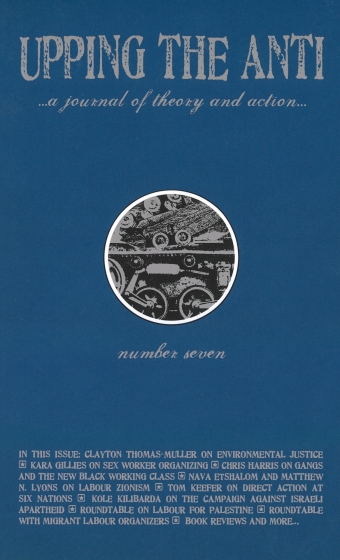Spotlight on the CFS
Dear UTA,
I’d like to thank you for your ongoing examination of student activism and student models of organizing. As a student activist and elected representative of the Guelph Central Students’ Association, I’ve spent the past year working with the Ontario executive of the Canadian Federation of Students (CFS) and attending the National and Provincial General Meetings. For this reason I’ve really appreciated the spotlight UTA has focused on the CFS, beginning with Caelie Frampton’s article “Strength in Numbers?” in UTA #5. As demonstrated by the response from Eric Newstadt in the last issue (“Accounting for the Student Movement”), Frampton’s piece has sparked a lively debate and brought about important opportunities for critical reflection on the CFS by leftist students in Canada. While some within the CFS see public critique as divisive and therefore strategically unsound in the face of potential right-wing attacks and de-federation campaigns, I believe that public examination and critique is both important and necessary.
Although I didn’t find Frampton’s argument that we should leave the CFS for a completely new model of organizing extremely convincing, her article did highlight some important places to which students on the left can look in order to address problems with what is currently Canada’s most progressive national student organization.
While I say “most progressive,” the CFS on a national level rarely goes beyond ineffective lobbying while trying to make meaningful gains for students (and would-be students’) access to education. Even the recent announcement of a grants-based system to replace the former national Millennium Scholarship Foundation – a long time lobbying effort and a resulting victory for the federation – took 10 years to achieve. With so many people looking for financial support to access post-secondary education, a one-day rally every two years aimed at winning limited access to scholarships is not going to bring change fast enough.
Without a strategy that mobilizes on-going and escalating resistance, the CFS will lose credibility with students who realize that petitions, letters, and the odd “day of action” are easily ignored when those in power know what to expect. As the saying goes, if you always do what you’ve always done, you’ll always get what you’ve always got.
Contrary to Newstadt’s assessment that students today think of free education as too radical an idea, my experience in talking with hundreds of new students on the first day of school this year demonstrates the opposite. Not only did new students and those helping them move into residence agree that post-secondary education should and can be free, but they were excited by the idea of participating in CFS-Ontario’s campaign to Drop Fees. Although this campaign can still be interpreted as one for dramatically reduced or free tuition, it gives local members the ability to participate in a province-wide campaign and to mobilize around the idea of complete elimination of tuition.
Rather than being relegated to the closed history books of an “idealized past” as Newstadt argues, examples highlighted by Frampton such as the radical Student Activist newspaper and other initiatives that built a leftist current within the CFS are initiatives to re-examine avenues for creating coordinated action and solidarity. We need to strategize toward building a more mobilized, effective, and participatory student movement that isn’t afraid to make demands that would earn the “hard left” title derided by Newstadt.
Positive signs of a more radical practice are beginning to emerge within the Ontario component of the CFS with the launch of the Drop Fees campaign. Discussions about occupations and student strikes are back on the table. We are also actively participating in campaigns and actions with No One Is Illegal and organizing the first ever Ontario Campus Activist Assembly (OCAA). We have a growing commitment to solidarity work with indigenous peoples in their struggle for land and justice. Along similar lines to the Student Activist newspaper mentioned by Frampton, the Ontario component of CFS is currently working on the first edition of a province-wide student paper. For this momentum to continue, student unions will have to include, support, and collaborate with groups on campus. They will need to make connections with society at large and, most importantly, build solidarity with anti-poverty, anti-corporate, pro-labour, and pro-democracy grassroots organizations.
The OCAA is a positive step in this direction. We are planning workshops on anti-war organizing and fighting for anti-corporate campuses as well as on the struggles of undocumented and indigenous people, free tuition models, student assemblies and strikes in Québec, high school organizing, and more. Participants can also promote and conduct their own workshops on issues not incorporated in the schedule. The OCAA demonstrates how the CFS can work to build a grassroots student movement that goes beyond established student leaders in order to build the skills, political consciousness, and capacities required for high school and university students to organize in solidarity with labour unions and other sectors of their communities working for social justice.
If we claim to be a student movement, we’re going to have to prove it by winning more than a change in government policy every 10 years and annual demonstrations for a tuition freeze. Like the courageous auto-critique of the new Students for a Democratic Society (UTA 6), continued critical engagement with and evaluation of the CFS is vital in order for it to move forward as a left student grassroots-directed organization capable of meaningful and effective coordinated action, student mobilization, and consciousness-raising. The recent examples emerging from the Ontario component of CFS can point toward the kind of organizing suggested by Frampton. In so doing, they help to push the Canadian Federation of Students to the left.
In solidarity,
Caelie Campbell
Guelph, Ontario

